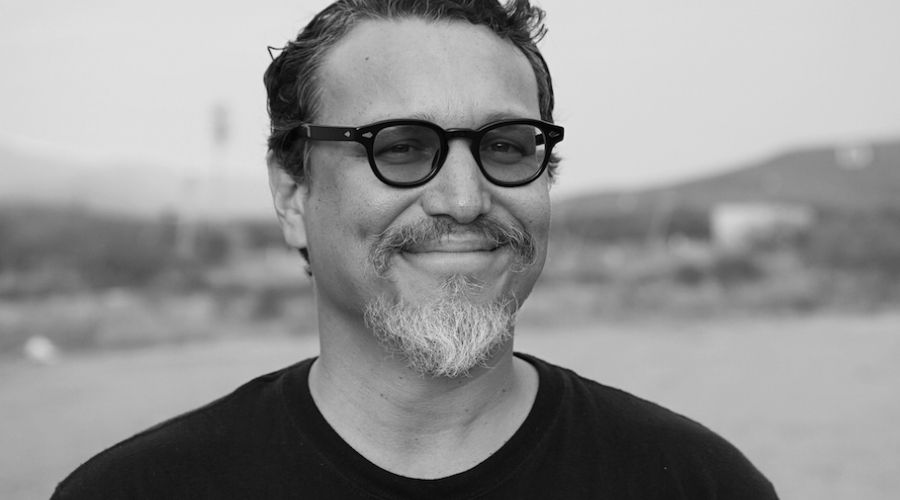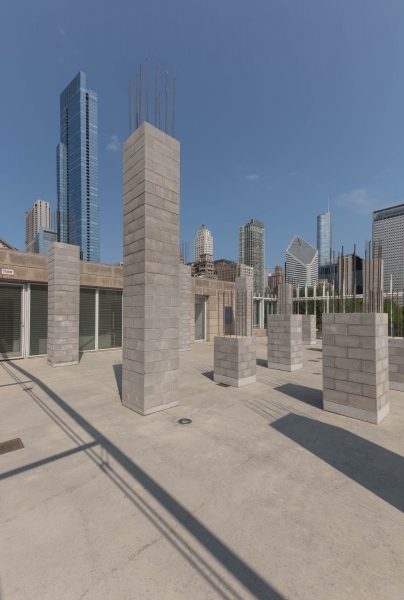
Visit the sculpture terrace of the Art Institute of Chicago’s modern wing through April 26, 2020, and you’ll see a number of columns of towering rebar and concrete cinder blocks in various states of completion. “A castillo,” says Kade L. Twist. The word literally translates to “castle” in Spanish, and is the term used to describe these unfinished columns found on many buildings in Mexico. Twist created the installation, titled “With Each Incentive,” with collaborator Cristóbal Martínez (they work together as Postcommodity), and explains that many buildings in Mexico are left unfinished, not only for the practical purposes of reducing property taxes, but also as an aspirational metaphor—the building is primed for an additional floor when it’s time to house the next generation of a growing family. At AIC, the columns cut a striking image against the polished Chicago skyline, and, Twist says, act as a metaphor of a different kind, calling attention to the “massive historic migration taking place, moving from south to north,” as well as the destructive role of the U.S. in causing that migration, and America’s treatment of immigrants and refugees from Mexico and Central and South America. It also “stands as a metaphor for placemaking—here’s something familiar to look at, that speaks to where you came from and who you are as cultures. Let’s let the institution build a new floor for this new migration.” 
Many of Postcommodity’s ongoing projects apply indigenous research methods to installations and performances to foster progressive dialogue—illuminating the historical impact of exploitative practices, and highlighting ways to engage a community from the place of their agency. This past summer, the duo had a residency at Santa Monica’s 18th Street Arts Center, where, in collaboration with sound artist Guillermo Galindo, they combined art and sonic practices to explore ways for discordant voices (and opinions) to find harmonization.
These works are real-world manifestations of the passion, insight, and issue-raising that Twist brings to Otis College of Art and Design as the Curricular Area Head of the MFA Fine Arts program’s emphasis in Art + Social Practice. Social practice is nothing new at the school—an MFA in Public Practice was initiated and overseen by artist Suzanne Lacy from 2007 to 2016. But this evolution of Lacy’s program, which Twist came to Otis College last year to launch, marks a new way of looking at the curriculum by bringing social practice into the MFA Fine Arts program. Doing so gives the emphasis a refreshing new context, holding students accountable to the art-making standards of the program while giving them access to a broader cohort of peer artists. Students in the Art + Social Practice emphasis participate in weekly interdisciplinary critiques (which Twist calls “the backbone” of the MFA program), have the opportunity for regular studio visits with a diverse range of instructors, and utilize the MFA Fine Arts studio space, fostering an inspiring camaraderie.
An important aspect of the new emphasis is a focus on the students’ development of their own work. “I’m emphasizing smaller projects that students design and implement themselves in a variety of socially collaborative environments,” Twist says. “As an interdisciplinary endeavor, this can take almost any form imaginable, so we focus on the building blocks of social practice, such as scored performances, interactive game pieces, interactive experiences, happenings, events, public mark making, and public works of sound, video, text, and sculptural installation. The key [underlying] driver of the work is investigating the dynamics and complexities of human relationships within discrete systems of power—social, cultural, political, economic, etc., and at the intersections of multiple systems of power.”
Twist, in addition to applying public policy and community development methods, will also be embedding American Indian research methodologies into every social practice class. “We apply indigenous research methods to the act of making socially engaged work, in terms of diplomacy, ethics, accountability, strategy, facilitation, design, and the exhibition or performance of the project, as well as the redistribution of knowledge and project outcomes throughout the life of the work” he says. “And then [students] get turned loose to make art, with the support of their peers, and myself, and the other faculty in the larger MFA Fine Arts program. It’s a safe, relatively low-risk environment to experiment, learn, acquire new skills, build the foundation of a sustainable art practice, and make powerful, impactful work that reminds us that we are human, and our human experience is shared and interconnected.”
Identity, diversity, and issues of power are some of the topical issues students in the Art + Social Practice emphasis have been poignantly exploring, as has the whole MFA Fine Arts program; courses that focus on collaborative projects have yielded panel discussions, film screenings, and even an absurd performance that turned a tiny gallery space into a bona fide roller rink. In the emphasis, some classes take place out in the field, allowing students to go to the Los Angeles locations of past Public Practice art projects to learn about the logistics of their presentation, how they were documented, their impact on the community, as well as how they’re remembered. This type of on-the-ground experience helps enforce the curriculum that Twist says aims to “open up some eyes and minds to the spaces that exist between what people expect social practice to be, and how artists actually make a living and can develop a sustainable career.”
Otis College and the MFA Fine Arts program provide fertile ground for Art + Social Practice to thrive, and Twist sees a burgeoning future for the emphasis—one that continues to build programming partnerships and facilitate research and discussion around points of reference beyond a Western Scientific Judeo-Christian worldview—and the students who go through it. “The foci of this Art + Social Practice emphasis is to put the students into a space to succeed, to learn how to construct an art practice that’s driven coherently by a discourse, how to engage a community of interest around that discourse in a way that is harmonizing, and then to be able to aestheticize the knowledge that has been recovered from the experience in a way that redistributes that knowledge to the larger public,” Twist says. “There are no books that are going to satisfactorily deliver what the students get access to, and that’s probably the best part about it.”
Art + Social Practice was an optional emphasis of the MFA Fine Arts program at Otis College of Art and Design.


